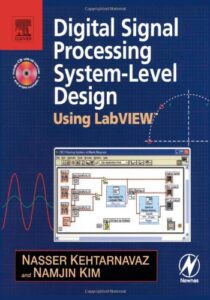| Book Name: | Digital Signal Processing System-Level Design Using LabVIEW |
| Category: | Electrical books ( EE ) |
| Language: | English |
| Format: | |
| Free Download: | Available |
Digital Signal Processing System-Level Design Using LabVIEW by Nasser Kehtarnavaz and Namjin Kim | PDF Free Download.
| Book Details : | |
|---|---|
| Language | English |
| Pages | 305 |
| Format | |
| Size | 7.41 MB |
Digital Signal Processing System-Level Design Using LabVIEW

Digital Signal Processing Contents
- Chapter 1: Introduction
- Chapter 2: LabVIEW Programming Environment
- Lab 1: Getting Familiar with LabVIEW: Part I
- Lab 2: Getting Familiar with LabVIEW: Part II
- Chapter 3: Analog-to-Digital Signal Conversion
- Lab 3: Sampling, Quantization and Reconstruction
- Chapter 4: Digital Filtering
- Lab 4: FIR/IIR Filtering System Design
- Chapter 5: Fixed-Point versus Floating-Point
- Lab 5: Data Type and Scaling
- Chapter 6: Adaptive Filtering
- Lab 6: Adaptive Filtering Systems
- Chapter 7: Frequency Domain Processing
- Lab 7: FFT, STFT and DWT
- Chapter 8: DSP Implementation Platform: TMS320C6x Architecture and Software Tools
- Lab 8: Getting Familiar with Code Composer Studio
- Chapter 9: LabVIEW DSP Integration
- Lab 9: DSP Integration Examples
- Chapter 10: DSP System Design: Dual-Tone Multi-Frequency (DTMF) Signaling
- Lab 10: Dual-Tone Multi-Frequency
- Chapter 11: DSP System Design: Software-Defined Radio
- Lab 11: Building a 4-QAM Modem
- Chapter 12: DSP System Design: MP3 Player
- Lab 12: Implementation of MP3 Player in LabVIEW
Preface to Digital Signal Processing System-Level Design Using LabVIEW
I have been teaching DSP (Digital Signal Processing) lab courses using various TI (Texas Instruments) DSP platforms for many years. One question I have been getting from students in a consistent way is, “Do we have to know C to take DSP lab courses?” Until last year, my response was, “Yes, C is a prerequisite for taking DSP lab courses.”
However, last year for the first time, I provided a different response by saying, “Though preferred, it is not required to know C to take DSP lab courses.”
This change in my response came about because I started using LabVIEW to teach students how to design and analyze DSP systems in our DSP courses.
The widely available graphical programming environments such as LabVIEW have now reached the level of maturity that allows students and engineers to design and analyze DSP systems with ease and in a relatively shorter time as compared to C and MATLAB.
I have observed that many students taking DSP lab courses, particularly at the undergraduate level, often struggle and spend a fair amount of their time debugging C and MATLAB code instead of focusing on understanding signal processing system design issues.
The motivation behind writing this book has thus been to avoid this problem by adopting a graphical programming approach instead of the traditional and commonly used text-based programming approach in DSP lab courses.
As a result, this book allows students to put most of their efforts into building DSP systems rather than debugging C code when taking DSP lab courses.
One important point that needs to be mentioned here is that in order to optimize signal processing algorithms on a DSP processor, it is still required to know and use C and/or assembly programming.
The existing graphical programming environments are not meant to serve as optimizers when implementing signal processing algorithms on DSP processors or other hardware platforms.
This book addresses this point by providing two chapters dedicated solely to algorithm implementation on the TI family of TMS320C6000 DSP processors. It is envisioned that this alternative graphical programming approach to designing digital signal processing systems will allow more students to get exposed to the field of DSP.
In addition, the book is written in such a way that it can be used as a self-study guide by DSP engineers who wish to become familiar with LabVIEW and use it to design and analyze DSP systems.
I want to express my gratitude to NI (National Instruments) for their support of this book. In particular, I wish to thank Jim Cahow, Academic Resources Manager at NI, and Ravi Marawar, Academic Program Manager at NI, for their valuable feedback.
I am pleased to acknowledge Chuck Glaser, Senior Acquisition Editor at Elsevier, and Cathy Wicks, University Program Manager at TI, for promoting the book.
Finally, I am grateful to my family who put up with my preoccupation with this book-writing project.
Digital Signal Processing System-Level Design Using LabVIEW
Author(s): Nasser Kehtarnavaz, Namjin Kim
Publisher: Newnes, Year: 2005
ISBN: 9780750679145,075067914X
Download Digital Signal Processing System-Level Design Using LabVIEW in PDF Format For Free.









![[PDF] Draw Buildings and Cities in 15 Minutes Draw Buildings and Cities in 15 Minutes pdf](https://freepdfbook.com/wp-content/uploads/2021/06/Draw-Buildings-and-Cities-in-15-Minutes-218x150.jpg)








![[PDF] Digital Image Processing An Algorithmic Introduction Using Java Digital Image Processing An Algorithmic Introduction Using Java](https://freepdfbook.com/wp-content/uploads/2022/06/Digital-Image-Processing-An-Algorithmic-Introduction-Using-Java.jpg)




![[PDF] 43 Years JEE ADVANCED + JEE MAIN Chapterwise & Topicwise Solved Papers 43 Years JEE ADVANCED (1978-2020) + JEE MAIN Chapterwise & Topicwise Solved Papers Physics PDF](https://freepdfbook.com/wp-content/uploads/2022/03/43-Years-JEE-ADVANCED-1978-2020.jpg)

![[PDF] Problems in Physical Chemistry for JEE (Main & Advanced) Problems in Physical Chemistry for JEE (Main & Advanced) Free PDF Book Download](https://freepdfbook.com/wp-content/uploads/2022/03/Problems-in-Physical-Chemistry-for-JEE-Main-Advanced.jpg)
![[PDF] Engineering Physics (McGraw Hill)](https://freepdfbook.com/wp-content/uploads/2021/05/bafc8c2685bb6823a9c56134f7fba5df.jpeg)

![[PDF] Engineering Chemistry By Shashi Chawla](https://freepdfbook.com/wp-content/uploads/2022/05/Theory-And-Practicals-of-Engineering-Chemistry-By-Shashi-Chawla-free-pdf-book.jpeg)
![[PDF] Chemistry: An Introduction to Organic, Inorganic & Physical Chemistry Chemistry: An Introduction to Organic, Inorganic & Physical Chemistry](https://freepdfbook.com/wp-content/uploads/2022/04/Chemistry-An-Introduction-to-Organic-Inorganic-Physical-Chemistry.jpg)
![[PDF] Essentials of Physical Chemistry Essentials of Physical Chemistry Free PDF Book by Bahl](https://freepdfbook.com/wp-content/uploads/2022/04/Essentials-of-Physical-Chemistry-bahl.jpg)
![[PDF] Biological control of plant-parasitic nematodes: soil ecosystem management in sustainable agriculture Biological control of plant-parasitic nematodes: soil ecosystem management in sustainable agriculture](https://freepdfbook.com/wp-content/uploads/2022/05/Biological-control-of-plant-parasitic-nematodes-soil-ecosystem-management-in-sustainable-agriculture.jpg)
![[PDF] Human Anatomy: Color Atlas and Textbook Human Anatomy: Color Atlas and Textbook Free PDF Book](https://freepdfbook.com/wp-content/uploads/2022/05/Human-Anatomy-Color-Atlas-and-Textbook.jpg)
![[PDF] Concepts of Biology Book [Free Download]](https://freepdfbook.com/wp-content/uploads/2022/05/Concepts-of-Biology.jpg)
![[PDF] Essentials of Biology [Free Download] Essentials of Biology Free PDF BOok Download](https://freepdfbook.com/wp-content/uploads/2022/05/Essentials-of-Biology-Free-PDF-Book-Downlaod.jpg)
![[PDF] Human Biology Book [Free Download]](https://freepdfbook.com/wp-content/uploads/2022/05/PDF-Human-Biology-Book-Free-Download.jpg)